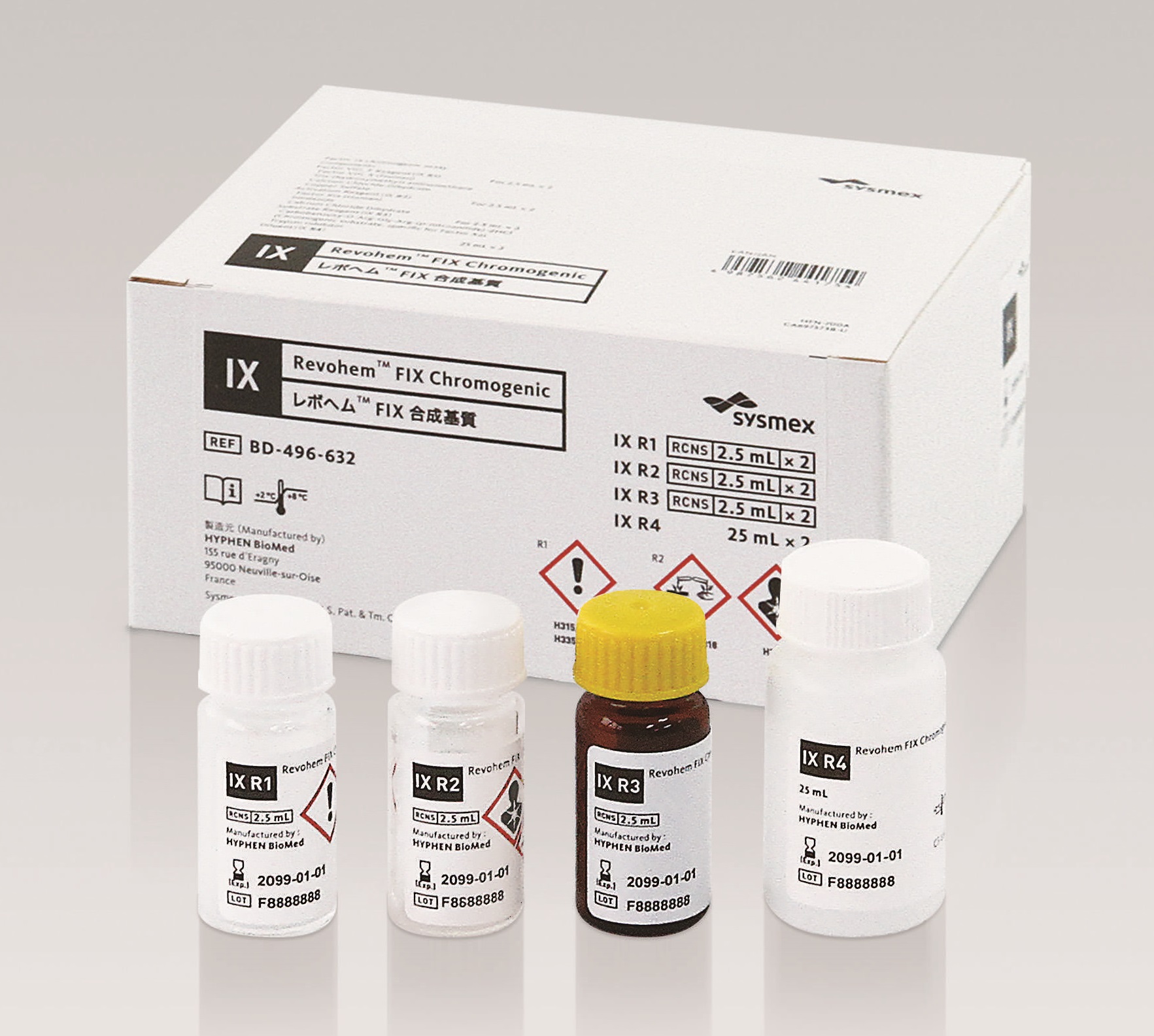Sysmex Launches Revohem FIX Chromogenic, a Blood Coagulation Factor IX Measurement Kit -Japan’s First Coagulation Factor IX Measurement Kit Using Chromogenic Assay, Helping to Diagnose and Assist in the Treatment of Hemophilia B-
Sysmex Corporation (HQ: Kobe, Japan; Chairman and CEO: Hisashi Ietsugu) has launched a new product in the hemostasis field: Revohem FIX Chromogenic, a blood coagulation factor IX measurement kit. The new product can be used with Sysmex’s Automated Blood Coagulation Analyzers CS-5100/CS-2500/CS-2400 and CS-2100i/CS-2000i/CS-1600 (“CS-Series”). This product, which helps to diagnose and assist in the treatment of hemophilia B,1 is the first kit on the market in Japan for measuring coagulation factor IX in blood plasma using chromogenic assay as its measurement principle.
Hemophilia is caused by a deficiency of a protein that causes flowing blood to clot (coagulation factor) or a hemostatic irregularity when the protein fails to function properly. The disease is classified into two varieties—hemophilia A and hemophilia B—depending on the type of coagulation factor. Hemophilia B is a hemorrhagic disease that occurs due to a reduced hemostatic function or a lack of coagulation factor IX in the blood. The general method of treatment is replacement therapy, using coagulation factor IX. Accurate quantitative testing for coagulation factor IX is important in diagnosing hemophilia B (determining the degree of severity), determining the appropriate drug administration volume and frequency, and post-administration monitoring.
Quantitative testing for coagulation factor IX mainly uses the coagulation one-stage assay (using an APTT2 reagent). However, with this method, measurement values are known to deviate, depending on the type of reagent used. Furthermore, recent years have seen progress in the development and practical use of drugs to extend the half-life of coagulation factors,3 aimed at reducing the administration frequency of coagulation factor therapy, and the chromogenic assay has demonstrated clinical usefulness in monitoring following the administration of these therapies.4 For these reasons, in Europe and the Americas the chromogenic assay is commonplace for measuring the quantity of coagulation factor IX.5,6 In Japan, The Japanese Society on Thrombosis and Hemostasis has established a working group to consider the introduction of the chromogenic assay for measuring the titer levels of factor IX.7
The product Sysmex is launching, the Revohem FIX Chromogenic, is a blood coagulation factor IX measurement kit for the automated quantitative testing of coagulation factor IX using the chromogenic assay for measurement with the CS-Series. By strengthening its reagent lineup with products that have high clinical usefulness such as this product, as well as the Revohem FVIII Chromogenic (launched in September 2017), which helps to diagnose and assist in the treatment of hemophilia A, Sysmex aims to augment the superiority of the CS-Series. By promoting the sale of this product, Sysmex is boosting recognition of the clinical superiority of qualitative testing for coagulation factor IX using chromogenic assays and contributing to the diagnosis and treatment of hemophilia B.
Sysmex aims to continue working to reduce the burden on patients and help boost the quality of testing, while supporting its customers.
New Product Overview
Name: Revohem FIX Chromogenic
Target use: Measuring coagulation factor IX in blood plasma
Target market: Japan
Target facilities: Large-scale hospitals, commercial labs, other
Launch: December 2018
NHI points: 229
Product Photo

Terminology
- Hemophilia: Hemophilia is of two types, hemophilia A and hemophilia B. Hemophilia A results from a deficiency of, or reduced function in, blood coagulation factor VIII, while hemophilia B is caused by a deficiency of, or reduced function in, blood coagulation factor IX. Hemophilia is diagnosed when the titer of factor VIII or factor IX is less than 40%. The degree of disease is classified according to titer level: severe for titer levels of less than 1%, moderate for between 1% and 5%, and mild for 5% and up.
- Activated partial thromboplastin time (APTT): This testing parameter is used when determining activation and abnormalities among intrinsic coagulation factors. This parameter is used along with prothrombin time (PT) to determine activation and abnormalities among extrinsic coagulation factors when screening for hemostatic function.
- Drugs to extend the half-life of coagulation factors: These drugs extend the half-life in the blood plasma beyond that of conventional blood coagulation factor drugs, allowing for regular administration only once every three to five days—or once per week depending on the patient’s disease state. Such drugs are therefore expected to decrease the frequency of intravenous injection, reducing the burden on the patient.
- S. Kitchen, et al. Haemophilia (2016), 22 (Suppl. 5), 72–77
- European Medicines Agency guidelines call for the use of chromogenic assays to measure the titer of coagulation factor drugs.
- A proposal by the Medical and Scientific Advisory Council (MASAC) calls for the US Food and Drug Administration (FDA) to swiftly approve chromogenic assays to enable the appropriate and safe use of new coagulation factor drugs (drugs to extend the half-life of coagulation factors).
- Hemophilia Group, The Japanese Society on Thrombosis and Hemostasis, 2017, 28(4), 557–559.
Reference
September 26, 2017 press release: “Sysmex Launches the Revohem FVIII Chromogenic, a Coagulation Factor VIII Assay Reagent – Helping to Diagnose and Assist in Treatment of Hemophilia A-”
https://www.sysmex.co.jp/en/corporate/news/2017/170926.html
*Information contained in the press release is current as of the date of the announcement, but may be subject to change without prior notice.
